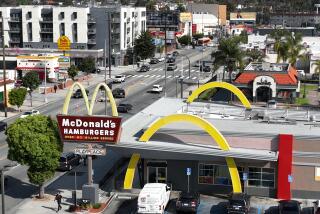Food Prices Expected to Stabilize in 1991 After Two Consecutive Yearly Increases
- Share via
Food prices, which have risen sharply in the past two years, will stabilize somewhat in 1991, according to a federal agriculture economist’s forecast.
The projection is surprising because it comes at a time of oil market uncertainty, reduced red meat production and recent weather damage to California’s produce industry.
The cost of food, calculated by the government as including meals eaten at home and in restaurants, rose at an annual rate of 5.8% each in 1989 and 1990.
“These back-to-back annual increases of 5.8% were the highest (for consecutive years) since 1980-1981,” according to Denis F. Dunham of the U.S. Department of Agriculture, who spoke at a recent food industry gathering in Los Angeles.
However, in 1991, overall food cost increases are expected to slow to between 2% and 5%, Dunham said.
Meals eaten at home, which account for 62% of consumers’ food budget, are expected to stem food price inflation by rising between 1% and 4% this year. However, the average cost of restaurant meals will continue a steady climb of about 5% annually.
Some of the factors currently slowing food prices include increased production of milk and poultry, as well as lower prices paid to farmers for most other commodities.
“In contrast to last year, farm prices in 1991 are expected to average 5% to 6% lower than in 1990 and moderate the rise in retail food prices,” Dunham said. “If the decline in farm (crop) value is totally passed through to consumers (then) the rise in (overall) food costs would be reduced 1% to 2%.”
Restaurant meals, which are less sensitive to commodity price changes, will continue their recent upward trend, he said.
Dunham said that food costs in Southern California will mirror the national picture.
“Last year, food in the Los Angeles area was 5.5% above 1989 levels while prices nationwide rose 5.8%. Food prices at grocery stores rose 6.2% in this area compared with 6.5% nationwide. Restaurant meals rose 4.4% in this market, which was slightly lower than the average rise in prices across the country,” he said. “Over the past three years, the rise in food prices in this area also has been similar to the nationwide increase in prices.”
The USDA statistics, which are gathered from the Consumer Price Index, contradict claims by Southern California supermarket representatives, who have regularly stated that food costs in this region are well below the national average, due to the “intense competition” between the major chains.
The USDA’s outlook for some of the major food commodities in 1991:
* Beef: Production up slightly; prices expected to jump between 1% and 4%.
* Pork: Production steady; prices up between 2% and 4%.
* Poultry: Increased supplies will trigger 1% to 5% price declines.
* Eggs: Prices expected to remain high as production levels stagnate.
* Dairy Products: Milk production will increase, causing prices to drop between 1% and 4%.
* Fresh Fruit: Weather damage in California will be responsible for a 5% to 8% jump in prices.
* Fresh Vegetables: Production steady, weather problems minimized and prices expected to drop slightly or increase by 1%.
More to Read
Inside the business of entertainment
The Wide Shot brings you news, analysis and insights on everything from streaming wars to production — and what it all means for the future.
You may occasionally receive promotional content from the Los Angeles Times.










